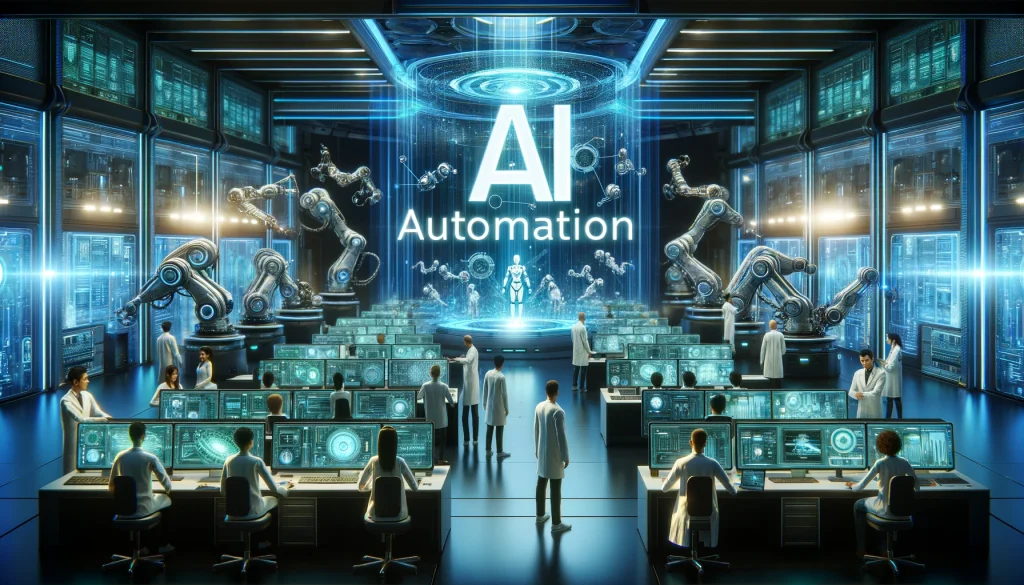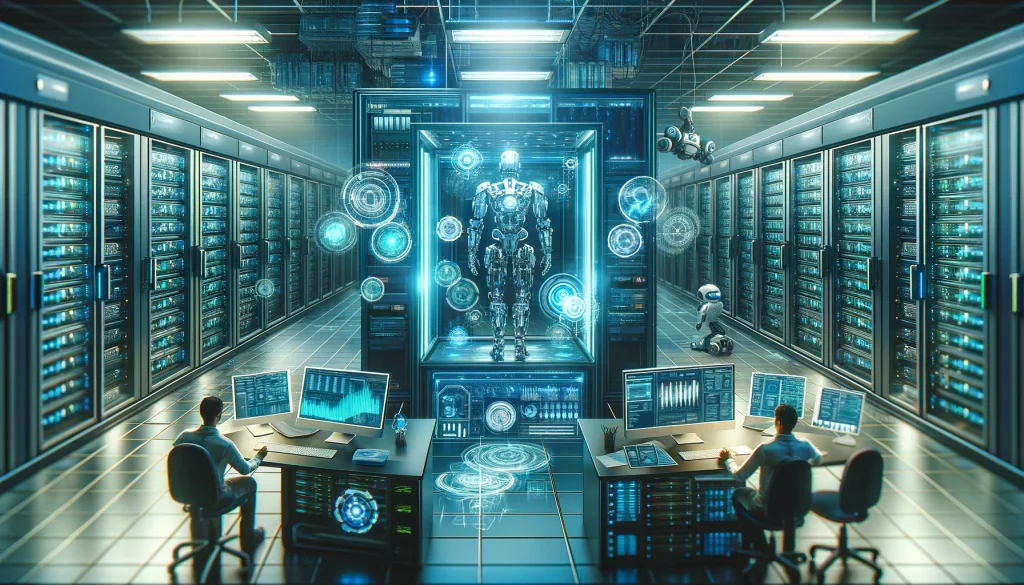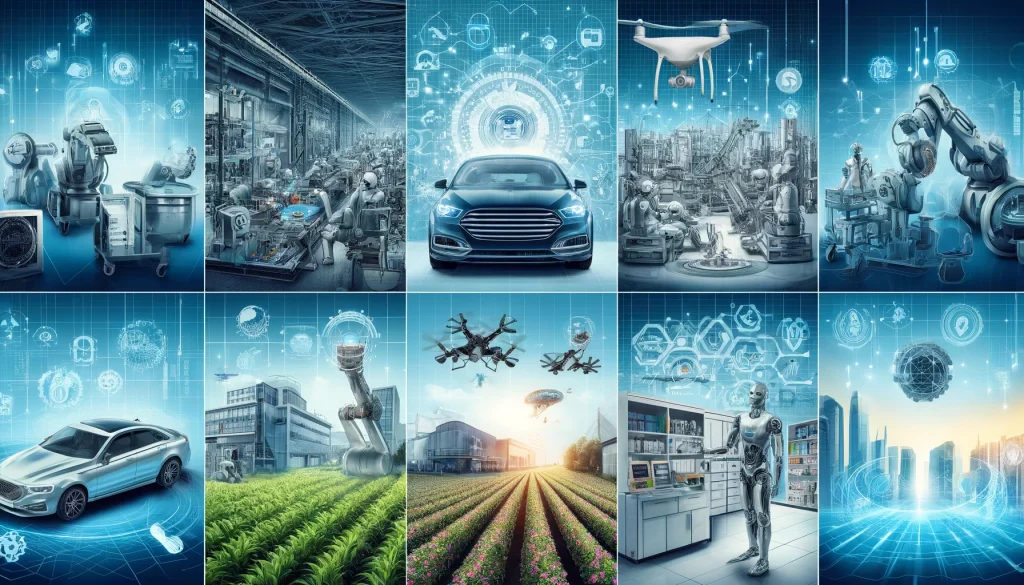Artificial Intelligence (AI) automation is revolutionizing industries by automating careers and procedures that traditionally demand human intervention. By leveraging AI technologies, institutions can facilitate business functions, address skillfulness and labor deficiencies, and free employees from duplicative work to concentrate on higher-value strategic jobs. This article delves into AI automation, analyzing its applied benefits across different sectors and its influence on productivity.
Key Takeaways
- AI automation uses AI technologies to automate jobs traditionally needing human intervention, improving efficiency and productivity.
- Applied uses of AI automation span numerous industries, including healthcare, finance, and manufacturing.
- Benefits of AI automation include improved efficiency, cost decrease, and improved decision-making abilities.
- Challenges in AI automation implicate data privacy considerations, performance costs, and the demand for competent personnel.
- Future tendencies in AI automation point towards integration with IoT, progress in machine learning, and development across different industries.
On an actual call, IVA system will have more information about the caller and will be
able to interact more intelligently with the caller. 1-888-639-9106
Understanding AI Automation

AI automation utilizes Artificial Intelligence technologies to automate works and methods that traditionally need human intervention. It authorizes institutions to expand their human workers with these AI digital workers to facilitate business functions. This enables sales with aptitudes and labor deficiencies and releases employees from tiresome, redundant jobs so they can concentrate on higher-value strategic jobs.
Automation vs. AI: Meaning, Differences

Artificial intelligence (AI) and automation are usually noted jointly in media talks, but they denote additional images. While they transfer some resemblances, it’s essential to comprehend their distinctive functions.
Automation concerns utilizing technical technology and software to complete repetitive works that do not alter over the period, such as tucking cardboard into distinct forms or automatically emailing receipts after online investments. In distinction, AI is about creating machines that can achieve complex decision-making jobs generally done by humans, like researching data collections, creating forecasts, and categorizing images.
Both AI and automation are revolutionizing our proficient and personal lives. This article will analyze the distinctions between automation and AI, their different applications, and the advantages they suggest. Besides, you’ll find online courses that can improve your knowledge of AI and its performance.
How AI Automation Differs from Traditional Automation

Traditional automation applies predefined controls and scripts to execute jobs, whereas AI automation leverages machine understanding, deep learning, and natural language processing to create findings and adjust to recent conditions. This adaptability makes AI automation better adaptable and competent in managing complex jobs corresponding to customary automation.
Why is AI important to automation?
Artificial Intelligence is essential to automation because it can explore and analyze large quantities of data much speedy and more accurately than a human can. This permits more efficient and streamlined operations in different industries. AI can also be employed to automate redundant tasks, liberating up human workers to concentrate on more complex and innovative factors of their careers.
In manufacturing, for instance, AI can be utilized to optimize production timetables, observe supply enactment, and expect keeping requirements. In consumer service, AI chatbots can be operated to control necessary queries and deliver personalized service to clients. In logistics, AI can be operated to optimize vehicle routes and control inventory groups.
Overall, AI is essential to automation because it can revolutionize various sectors by improving efficiency, decreasing costs, and enhancing decision-making procedures.
Key Components of AI Automation

Leveraging machine learning, AI imitates human thinking approaches, developing and purifying itself over time. This development includes the foundation of AI automation, which incorporates developed mental capabilities into workflows. Unlike conventional automation, which tracks predefined teachings, AI automation entrusts machines to understand, logic, and drive decisions unassisted, under human control.
The effect of AI automation is already detectable across diverse industries, reshaping business rules, redefining job functions, and pushing a powerful wave in productivity. According to a current Deloitte study, more than half of institutions aspired to incorporate AI and automation technologies into their functions by 2023. Besides, projections indicate that AI software earnings could get $307 billion by 2027, showing a genuine purpose of invention, efficiency, and competitive advantage.
Now, let’s delve into the basic elements of AI automation, its exceptional productivity enhancements, actionable guidance for performance, the advantages it presents, and the arising movements in the domain.
AI automation comprises many key elements:
- Machine Learning: Algorithms that permit systems to understand and enhance knowledge.
- Natural Language Processing (NLP): Allows machines to comprehend and react to human language.
- Robotic Process Automation (RPA): Automates repetitious jobs by simulating human activities.
- Computer Vision: Permits machines to analyze and make judgments founded on visible data.
Comprehending what is automation in the context of AI is important for leveraging its full prospect in diverse industries.
Automation use cases
Human mistakes can be reduced and productivity and efficiency can grow when a systematic set of techniques is utilized. There are several methods that automation can be important to a business, including:
Business automation

- Content management solutions are developed to grab, hold, trigger, explore, and automate the handling of business scope.
- Document processing resolutions leverage synthetic intelligence, including machine learning and natural speech processing, to facilitate the administration and processing of business papers.
- Document management solutions concentrate on grasping, pursuing, and keeping details from digital records.
- Workflow automation solutions use rules-based reasoning and algorithms to complete jobs with the tiniest to no human intervention.
- Decision management answers utilize machine learning to model, control, and automate business judgments.
- Process mapping solutions improve functional efficiency by determining back-ups and promoting cross-organizational cooperation and orchestration.
IT automation

- IT automation concerns developing and enforcing automated systems and software to substitute manual jobs that formerly demanded human action. This process speeds up the deployment and composition of IT infrastructure and applications, improving functions throughout the whole working lifecycle.
- Observability solutions enhance application implementation monitoring, delivering a more in-depth understanding of system implementation and the critical context to determine happenings more quickly.
- Cloud automation solutions miscalculate or destroy the manual duties applied in provisioning, configuring, and operating cloud circumstances. By improving efficiency, cloud mechanization allows institutions to completely leverage the advantages of cloud computing, such as on-demand key to cloud aids.
- Hybrid cloud cost optimization resolutions terminate the delay in cloud resourcing by using constant automation to preserve time and decrease expenses.
- Network performance management solutions improve IT functions through intelligent understandings, guiding to improved network stability and availability.
Integration
- Integration concerns linking data, applications, APIs, and devices across your IT association to enrich efficiency, productivity, and deftness.
- API management resolutions encourage the innovation, management, protection, advertising, and monetization of web application programming interfaces (APIs).
- Application integration solutions found associations between applications and data.
How AI automation is used in industries

AI Automation in Healthcare
AI automation is revolutionizing the healthcare industry by improving diagnostic precision and streamlining managerial jobs. AI can help healthcare providers in analyzing diseases more accurately and swiftly than conventional techniques. Further, AI tools assist in keeping patient records, organizing arrangements, and even observing patient health via wearable appliances.
AI Automation in Agriculture
AI AutomatiIn the empire of agriculture, AI has become increasingly dominant, improving different aspects of farming techniques. Through IoT devices, farmers can now observe soil and crop needs alongside weather ways, showing a unique period of accuracy in agriculture. Moreover, the growing availability of chronological and statistical data designates farmers to create instructed decisions and predict directions. In this terrain, AI plays a vital role by leveraging its analytical capabilities to sift through data and determine meaningful ways.
A unique model comes from John Deere, a famous player in the agricultural technology sector. Their See & Spray™ Ultimate sprayer utilizes artificial intelligence alongside computer concepts and machine learning technologies. These creative tools can distinguish between crops and weeds, selectively targeting weeds with herbicides while underrating the usage of chemicals. John Deere claims that this technology decreases herbicide consumption by over two-thirds, showcasing AI’s possibility to revolutionize conventional agricultural methods.
AI Automation in Finance
In the finance sector, AI automation is employed to examine market directions, catch deceitful actions, and handle customer service queries. AI algorithms can process extensive quantities of financial data to create precise forecasts about market trends. Automated systems also assist in real-time deception detection, guaranteeing the safety of financial dealings.
AI Automation in Manufacturing
Manufacturing industries leverage AI automation for predictive upkeep, quality management, and store chain optimization. AI systems observe equipment to expect losses before they happen, thus decreasing downtime. They also guarantee that yields meet grade standards by recognizing imperfections during the production cycle. Similarly, AI optimizes supply chain management by forecasting ultimatum and controlling stock levels efficiently.
Benefits of AI Automation
Increased Efficiency and Productivity
AI automation especially improves efficiency and productivity by carrying over redundant and everyday chores. This permits human employees to concentrate on more strategic and innovative actions, thereby causing innovation and evolution within the community. AI systems can work 24/7 without exhaustion, providing continued productivity.
Process Optimization
Integrating the power of AI and automation streamlines business operations, using progressive technologies like machine learning to promote business strategy management. This integration aligns groups with administrative goals, enabling the attainment of operational marks.
From exploring data to automating redundant tasks, this technique helps team members make well-informed judgments by providing appropriate details in real time. Eventually, the objective is to decrease mistakes, improve productivity, and promote overall working efficiency.
Enhancing Operational Resilience
AI automation certifies organizations to expect and adjust to varying events and movements, improving functional stability. This integration enables the seamless incorporation of appearing technologies, facilitating quick reactions to AI insights. By leveraging AI automation, big enterprises can efficiently change their operational strategies to guide apprehensions and welcome evolution virtually.
Cost Reduction
Implementing AI automation can show significant cost conserving. By decreasing the demand for manual work and reducing mistakes, businesses can reduce operational expenses. Besides, AI-driven predictive upkeep can stop costly supply losses, additionally donating to cost efficiency.
Enhanced Decision Making
AI automation supplies useful insights via data analysis, allowing better decision-making methods. With the capacity to process extensive amounts of data fast, AI systems can recognize habits and movements that might be ignored by human research. This data-driven system provides more knowledgeable and precise judgments, eventually helping the community.
Enhancing Customer Engagement through Personalization
AI revolutionizes customer adventures by tailoring relations and automating common jobs. For instance, AI-driven casual chatbots deliver active customer support established on live relations. By examining conduct, choices, and past investments, AI algorithms provide personalized product suggestions, improving customer concentration. Moreover, by leveraging chronological data, AI allows companies to predict customer requirements.
Unlocking Next-Level Productivity with AI Automation: Three Key Strategies
- Embrace Strategic Implementation Rather than aimlessly adopting AI automation, a strategic process is important for long-term wins. This controls challenges like advanced IT keeping expenses, resource deficiencies, and contradicting technology advancements. By strategically designing AI automation enterprises, associations can bypass fragmented resolutions and provide cohesive administration.
- Embrace a Holistic Platform Approach Move above-separated task automation, such as robotic process automation (RPA), and adopt a complete platform approach. This process combines different digital technologies, enabling smoother exchanges across customer and employee expeditions. By leveraging a powerful data management architecture like a data material, communities can improve cooperation between digital devices, operating efficiency, and invention.
- Prioritize Data Quality and Accessibility High-quality data is essential for maximizing the advantages of AI automation. Setting a healthy semantic layer, such as a data material, concentrates and normalizes data across the company. This guarantees that AI models have the key to appropriate and trustworthy data, allowing them to develop practical understandings and enhance operational efficiency. Also, integrating AI outputs into workflows through procedure automation improves productivity and improves customer affairs. A personal AI strategy provides data protection while leveraging the maximum prospect of AI technologies.
Challenges and Considerations
Data Privacy Concerns
One of the preliminary challenges in AI automation is providing data privacy. With the increasing amount of data being processed, safeguarding exposed information becomes critical. Companies must attach to strict data protection rules and execute robust security standards to stop data breaches.
Implementation Costs
Implementing AI automation can be a pricey enterprise. The initial investment in technology, infrastructure, and trained personnel can be powerful. Further, ongoing supervision and updates count toward the overall expenses. Communities ought to carefully consider the return on investment (ROI) before dedicating it to AI automation tasks.
Skill Requirements
AI automation needs specialized mastery and expertise. Locating and keeping talent with the required knowledge in AI and machine learning can be difficult. Companies may be required to finance training programs to upskill their current workforce or engage fresh talent, which can be both time-consuming and costly.
While AI automation delivers multiple advantages, it is important to manage these challenges to provide successful performance and maximize the possibility of AI technologies.
3 Transformative AI automation Trends to watch.
Integration with IoT
The integration of AI with the Internet of Things (IoT) is set to revolutionize different industries. AI algorithms will process data from IoT devices in real time, allowing smarter decision-making and mechanization. This synergy will improve predictive upkeep, optimize energy consumption, and enhance overall working efficiency.
Harnessing the Power of AI and RPA Integration
Integrating AI with RPA delivers transformative outcomes by automating both mental and redundant studies, thereby optimizing operations and improving team workflow efficiency. While RPA excels at automating high-volume, repetitious jobs, it may not always be the most efficient resolution for jobs needing tough decision-making procedures. In such circumstances, AI presents a more practical technique, especially for chores like email category or fraud forecast. The synergy between AI and RPA optimizes workflows organization-wide, pushing beyond remote automation examples to make a cohesive automation system.
Advancements in Machine Learning
In the future years, we can wish for AI automation to develop with more refined algorithms and improved natural language processing. These improvements will make AI tools more instinctive and user-friendly, allowing for more comprehensive performance across industries. The continued progress in machine learning models will also guide to more precise forecasts and more suitable handling of complicated assignments.
Expansion in Various Industries
AI automation is balanced to develop into new sectors, having a substantial effect on international economizing. Industries such as healthcare, finance, and manufacturing will see improved adoption of AI technologies, and coaching to enhance efficiency and productivity. According to the World Economic Forum, AI could make 97 million positions while substituting 85 million others by 2025, emphasizing the transformative possibility of AI automation.
The fortune of AI automation is loaded with possibilities and challenges. Businesses must adjust to these differences to remain competitive and leverage the maximum prospect of AI technologies.
Improving Workplace Productivity with AI Automation
Streamlining Administrative Tasks
AI automation can dramatically improve productivity by enduring redundant and everyday organizational studies. By automating data entry, scheduling, and other routine movements, employees can concentrate on more strategic work that needs human invention and brilliance. This change not only improves efficiency but also raises employee pride and creation.
Enhancing Customer Service
AI-powered chatbots and virtual helpers can supply 24/7 customer aid, fixing common problems and responding to continually asked questions. This not only enhances customer satisfaction but also releases human representatives to take more difficult questions. Intelligent systems can examine customer relations to deliver personalized backgrounds, further improving service differentiation.
Optimizing Supply Chain Management
AI automation can optimize stockpile chain functions by forecasting needs, controlling products, and corresponding logistics. These methods can explore extensive amounts of data to make educated judgments, decreasing uncertainties and underestimating prices. The outcome is a more efficient and responsive supply chain that can adjust to altering market circumstances.
AI automation is not just about returning human jobs; it’s about increasing human abilities to gain more significant productivity and invention in the workplace.
Is Your Business Ready to Embrace AI Automation?
Artificial intelligence is currently an enduring institution in the business terrain, and despite the problems it may present, its benefits are indisputable. When combined with complete human intelligence within a managed location, AI can greatly improve business productivity and implementation.
Leveraging AI and automation devices virtually need a particular level of technological maturity, including mastery, understanding, and background. However, this should not prevent you from following AI-assisted conversion and analyzing its extensive usefulness. Contact Intellias for help in embracing artificial intelligence and other cutting-edge technologies. The expertise will allow you to harness these inventions for your victory, development, and competitive benefit.
Conclusion
AI automation is revolutionizing the method companies work by streamlining operations, improving productivity, and helping employees concentrate on more strategic assignments. By combining AI technologies into different systems, organizations can overwhelm labor deficiencies, lower manual actions, and make more knowledgeable conclusions based on data-driven understandings. As AI continues to grow, its applications will grow, delivering even more significant possibilities for creation and efficiency. Adopting AI automation is not just a direction but a strategic movement toward a more efficient and competitive fate.
Frequently Asked Questions
What is AI automation?
AI automation utilizes Artificial Intelligence technologies to automate jobs and functions that traditionally need human intervention. It authorizes organizations to increase their human employees with AI digital workers to facilitate business operations.
How does AI automation differ from traditional automation?
Traditional automation generally applies to predefined, rule-based jobs, while AI automation utilizes machine knowledge and other AI technologies to complete tasks that need human-like decision-making and adaptability.
What are some key components of AI automation?
Key features of AI automation include machine learning, natural language processing, and robotic approach automation. These technologies work jointly to explore data, make judgments, and complete tasks autonomously.
How is AI automation applied in healthcare?
In healthcare, AI automation is utilized for tasks such as analyzing diseases, personalizing treatment programs, and handling patient forms. It assists enhance precision and efficiency in medical procedures.
What are the benefits of AI automation in the workplace?
AI automation improves efficiency and productivity, decreases costs, and improves decision-making by automating redundant assignments and permitting employees to concentrate on higher-value strategic positions.
What challenges are associated with implementing AI automation?
Challenges include data privacy problems, high performance expenses, and the demand for technical skillfulness to operate and sustain AI systems.
How secure is AI automation?
The security of AI automation systems offers multifaceted and developing challenges. These include problems linked to data, model integrity, algorithmic fairness, transparency, authentication, deployment security, ongoing monitoring, and regulatory submission. Virtually connecting AI automation demands a broad strategy that contains these elements and changes to improvements in AI technologies.
